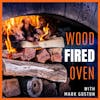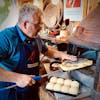Live Cook - Lamb Tagine with Aubergine and Vine ripened tomatoes cooked in the Wood Fired Oven

It's Tagine time! Join me in front of my wood fired oven as I cook one of my absolute favourite dishes. The dish had a couple of lucky escapes as I make two complete fails as I prepare this in my flaming hot brick oven! Listen in if you want to learn what not to do.
Thankfully, the finished dish is amazing - you are guaranteed to smell it through your podcast app!
If you are from Morocco or other nearby regions, I would love to hear from you. Share with my listeners your tips and tricks to supercharge our Moroccan inspired wood fired oven dishes. Get in touch with me at woodfiredoven.cooking
Here is a great Moroccan clay Tagine: https://amzn.to/2VQzQXw
Grab your copy of the One Thousand and One Nights: https://amzn.to/3ihziT1
If you choose to purchase from the links above, I may earn a small affiliate fee to help support the show.
The Fire Brick Company
The Fire Brick Company specialises in producing world class Wood Fired Pizza Oven Kits.
I am very grateful to the Fire Brick Company for sponsoring the show. If you are thinking of building your own Wood Fired Oven, head on over to The Fire Brick Company website - www.thefirebrickco.com/WFOpodcast where they have a little something for you.
Become a Supporter of the show
Please consider supporting the Wood Fired Oven Podcast. I am very grateful to all those who support the show. Every little bit helps to cover costs. Support the show here.
Leave a review
Please leave a review on Apple Podcasts to let me know what you think of the show.
My website
Check out my website for episode show notes and links, wood fired oven tips and advice, pictures and recipes: woodfiredoven.cooking
Social
Instagram: marks_WoodFiredOven
Facebook: Wood Fired Oven Chronicles Facebook group
YouTube: @woodfiredovenpodcast
Twitter: @WFOPodcast
Recommended Wood Fired Oven books
Check out my favourite books. They have helped me a lot, both with cooking in my wood fired oven and learning to cook with fire. Some of these have also been recommended to me by friends of my podcast.
Mark (00:07):
Gday - Welcome to the Wood Fired Oven podcast where I take a deep dive into the techniques, recipes and history of wood fired oven cooking. My name is Mark an obsessed and somewhat curious fan of outdoor cooking - especially with my wood fired oven. Follow my podcast in your favourite app and listen in, as I go searching for the best recipes, tips and advice, to both supercharge our cooking skills and motivate you to light up your favourite outdoor cooking gear this weekend.
Mark (00:42):
Welcome to my backyard, and welcome to my wood fired oven. I'm standing in front of 105 centimeters, of hot floor bricks inside my oven. I've had the fire on for about two hours now, and it's just looking fantastic. It's a bit of an overcast day here at my place, with a touch of rain in the air. So fingers crossed, it stays away.
Mark (01:01):
I'm going to be cooking Lamb Tagine with Aubergine and Vine ripened tomatoes in my Moroccan clay unglazed tagine this afternoon. If you haven't checked out episode five, after this episode, I suggest you go check it out. I take a deep dive into the different types of tagines, the history of the tagines and why they are such a good fit for your wood fired oven cooking. They're typically two types of tagines, a glazed tagine and an unglazed two tagine. I've got two unglazed tagines, and I think these give a beautiful earthy flavor to the finished food. You have to be a little careful when working with them as they are a little bit delicate, but they are well worth the extra effort.
Mark (01:42):
So I use two aubergines, typically in this recipe, it depends a little bit how big they are. I've sliced those aubergines up and I've placed them in the kitchen sink inside a colander, and I've sprinkled these liberally with salt, and I'm just going to leave them in the colander, draining the moisture from the aubergines for the next hour or so. I've come out here now to the wood fired oven. And I'm about to make some saffron water. If you haven't listened to episode five, I go into a bit of detail about saffron, but this is one of the key ingredients in this lamb tagine dish. It's pretty simple to make. I've placed about a tablespoon of saffron in a warm cazuela dish. And I'm just pushing that into the oven now, and I'm gently going to roast it until it just starts to smoke. When it's gently smoking away we're going to add in about a cup of warm water. Now it's really important that when you apply water to a warm tagine, that you make sure the water is not cold. So either hot or really hot because otherwise particularly an unglazed tagine could crack the pottery.
Mark (02:45):
So I keep a very, very close eye on the saffron, when it's in the oven. It's expensive. Saffron is the world's most expensive spice. It's around about five to 7,000 US dollars, a kilo. And that is pretty expensive. There are good reasons for that. Check out episode five for that, but in Australia, locally produced saffron here costs about 50 to 60, thousand dollars a kilos, which is about the same price as a kilo of gold. So it is pretty expensive. It's a good incentive isn't it not to burn your saffron when you're dry roasting here in the wood fired oven? Like I did one time. So you can hear that I'm regularly checking the Saffron here and just starting to smoke now.
Mark (03:25):
So I'm gonna pour in this warmed, cup of water and then pop it back in to the wood fired oven until it simmers. And that's going to be maybe 10 minutes or so. Okay. So 10 minutes has gone by and the saffron water inside the cazuela - I can already tell it's going quite yellowy and orange, and that's just wonderful. I'm going to pour it out now into a clear glass jug and oh yeah, that's really golden. It's a real transformation really happens when you simmer saffron. It's just lovely. Oh, the smell coming off that is beautiful. I really like saffron. It has a sort of a sweet hay earthy aroma to it. It's just lovely. Now I've had the tagine in the wood fired oven warming up for the last 30 minutes or so. My base of the tagine - the bowl itself is actually quite thick. It's probably around, eight mm thick. I would think I'm just pouring in some, oil now into the tagine and popping that back into the wood fired oven for a few minutes to warm up.
Mark (04:27):
Okay. So the oil is nice and warm. Now I'm going to add in the lamb into the tagine. Now I use lamb shoulder, I think that's the best cut of the animal for this particular dish. And I've got about a kilo just over a kilo of gorgeous lamb shoulder. That's lovely. I'm sprinkling over about a teaspoon or so of sea salt and some tumeric. I'm going to stir all that together and pop it back into the wood fired oven with the lid of the tagine on, and this conical lid on the tagine helps to retain the moisture in the meat and in the dish while it cooks. There's a large cavity above the dish. And that's one of the things that makes tagine cooking so, so unique and successful for these longer cooks and these tougher pieces of meat.
Mark (05:13):
If you didn't know, the tagine has a very, very rich history. In fact, it goes all the way back to at least the eighth century where it was documented in use in 1,001 nights or the Arabian nights, as you may know it.
Mark (05:29):
One of the things I sometimes do with this dish is roast a bunch of peppers in the wood fired oven to pop into it as well. It's not in the recipe on my website, which you're more than welcome to check out at WoodFiredOven.Cooking. I have this recipe and other recipes up for you to look at and use if you like. But I had a few roasted peppers left over from a dish I did the other day. So I've halved those, put them onto another terracotta dish. And I'm just just sliding those into the oven, just underneath where the fire is just underneath the andiron where peppers are going to get seriously licked by the flame.
Mark (06:00):
I want the skin on these peppers actually to turn black and then I'm going to pop them into a bag, steam them for about 10 minutes or so, and then peel them off and then put these peppers into this dish as well. Nothing quite like roasted peppers in the wood fired oven. Eat them on their own. We're going to do a little bit of that too, but pop them into this dish. It really adds a bit of zing to this dish. Nice and sweet.
Mark (06:19):
So I've got some crushed garlic and some pepper, and I'm going to stir these together in a small dish. I'm going to halve what I've made here and keep half aside for later. And with the remaining half, I'm going to add some fresh ginger, some black pepper, and I'm going to pour in a couple of tablespoons or so of the saffron water.
Mark (06:42):
And I'm gently going to stir that together as I drizzle in, about two, two and a half tablespoons of olive oil. That's smelling really nice. When that's well combined gonna pour in about 150 mls of hot water to this as well. And this gets added to the tagine shortly. I'm using two large fresh red onions, which I'm just slicing up here on the landing. I love red onions. Does anybody eat these raw? I know my grandfather used to eat these raw in his vegetable garden, but a little bit of raw red onion in your salads very nice. I've got a couple of bunches of coriander and flat leaf parsley as well. I'm going to rip off a handful of each, chop this up on the landing and that's about to go into the tagine as well. Okay. These are all now getting added to the tagine - lots of vibrant colours coming through here with the green parsley and the coriander and the fresh red onions.
Mark (07:37):
So I'm pouring in the garlic and pepper saffron oil mix now as well. And just stiring all that together. And already, the smell of the tumeric especially and the lamb coming off the bottom of the dish is really nice. So they've all been mixed through. Now, I'm putting the lid of the tagine on top of the main dish and sliding that back into the wood fired oven now, and that's going to slowly cook away for about two and a half hours. I'm putting the tagine in a cooler part of the oven, but the thick lid on the tagine does mean that super strong heat coming off the dome and off any flame, coupled with the moisture inside the dome, really does help to protect the food I did add in one cup of warm water before I closed the lid as well, just to ensure that over that two hours, it's not going to dry up. It really don't need much extra water.
Mark (08:25):
The tagine really is a fabulous piece of wood fired oven equipment. If you can get your hands on an unglazed tagine, that is fantastic. If you can only get yourself and it glazed tagine, go ahead and get that as well. The unglazed are a little hard to come by. I got my unglazed clay tagine from an African importer a few years ago. They are pretty hard to find, but if you can make that effort to find it, go ahead and do that. You won't be disappointed with the flavor profiles you get out of it. So this particular dish is a classic style of dish that you might find in Morocco. Now Morocco sits on the north western part of Africa and it's quite large, actually, Morocco, it's a little bit bigger than California for my American listeners.
Mark (09:05):
And it's basically divided up into three different regions. The foods out of North Africa and Morocco have a very, very long history. And I talk about those back in episode five, where we talked about the tagine in a bit more detail, but it is widely accepted that these influences of Northern Africa influenced the Romans and how they cook. And they enjoyed cooking and similar styles of dishes like I'm cooking here today. The Arab invasion actually of North Africa and the Moroccan region in the 7th century is widely believed to have heavily influenced the subsequent influence on the native cooking and the Arabs who love their breads and their spices brought their influence into Northern Africa. And they love the caraway seeds, their saffron, their ginger, cumin, cinnamon, all of those gorgeous spices that we now associate with north African Moroccan cuisine. That's where it's come from and great news from Morocco to unlike many other African countries, Morocco producers, all of the food that it needs to feed its people.
Mark (10:04):
And they love to grow their oranges and their sweet and hot peppers and their potatoes, and they just have done an extraordinarily good job in promoting their cuisine around the world. Moroccans also love their Couscous, which is basically very fine grains of wheat called semolina. And we also use semolina in our wood fired oven with our pizzas. Semolina is a little bit like small ball-bearings. So when you put some semolina on your pizza peel, you put your pizza dough on top of that and sliding that into the wood fired oven. Your pizza, while should slide easily off your peel because of the semolina, allowing the dough to roll off your peel into the wood fired oven.
Mark (10:38):
It's been two and a half hours, and I'm just bringing the tagine now out of the wood fired oven. It's sizzling away. Lovely. It's looking fantastic. The smells coming out of here, as the steam rises off in this cooling air is just beautiful. So I've taken these aubergines, which have been soaking with some salt in the colander, in the kitchen for a few hours. They're outside with me now. And I'm heating up some oil inside a large cazuela dish, and I'm going to gently fry off these aubergines and soften them right down over the next 10 to 15 minutes or so.
Mark (11:08):
When that's done, they're going to be added into the, tagine dish as well. So I'm just carefully putting in the aubergines into the oil, and I'm also popping in the red peppers as well. Sothey're sizzling away nicely, and I'll leave them now, pop them back into the oven for about 10 minutes to soften down. I've got around about a kilo, kilo and a half of vine-ripened tomatoes. I'm going to quarter these tomatoes. I like to leave them fairly chunky, and I'm going to add them into the tagine dish shortly. Now, you might remember, we reserved a little bit of the garlic and pepper mixture earlier. I'm now going to stir that through the eggplant mixture in this oil. That's a very inviting smell of the pepper and the garlic combined with the aubergine - that's lovely. I'm just going to add in some remaining spices. I've got some paprika, cumin and cayenne pepper that are going to get added in with the aubergines now, uh, No NO NO.... Got to be joking quick, quick, quick. So it tunes out that cayenne pepper and cumin look very similar in the fading light here. Oh, that was a genuine mistake. Don't know how I've done that. Scooping off the excess here. It's about light. It's already hopped into the oil. Well, that's going to be hot for the kids. Oh dear! Well, I won't to tell them, let's see if they notice in an hour or so. Oh no... thats a wee fail! M ost of the dishes that I cook are obviously toned down a little bit for my teenage kids. They don't mind it a little bit spicy, but yeah. I wonder if they'll notice.
Mark (12:44):
So I've now combined the parsley, the coriander, the tomatoes - they're all in the dish now, and I'm going to pop them all into the oven. So I'm just bringing the aubergines and tomatoes out of the oven. That's looking really nice. They've softened off a little bit. They've reduced in size a little bit as they have started to cook. I'm now going to tip this rather large cazeula dish into my tagine and stir all that through and just bringing out the tagine now as well, taking the lid off.
Mark (13:07):
Very important, if you're dealing with these unglazed tagins, that you don't take the hot, hot lid and place it on a cold bench or a cold landing in front of your oven because the lid might crack. So I've got a tea towel laid out here so I can gently put the conical domed lid down safely while I'm stirring it all through. I'm adding in the tomatoes. The aubergine now stiring that through - that looks just beautiful, sizzling away there nicely. There is a fair amount of moisture still in the bottom of the pot. I'm going to add in a little bit more warm water to the tagine dish before I pop the lid back on and pop it back into the wood fired oven for about an hour to finish off the cook.
Mark (13:45):
Okay. So I'm just adding in about three quarters of a cup of warm water to tagine. There is already a little bit of moisture in the bottom there, I just want to make sure for the next hour that there is no way that I'm going to burn the bottom of this, putting the lid on and sliding it into the oven. Hmmm, It would seem I've added a little bit too much water. As I put the lid on the water's coming up over the sides of the tagine and landing on the brick floor inside the wood oven. Oh No. Yeah. You can probably hear that. That's the water coming out. So I've over done that slightly. It's okay. Two options here. I can leave it in the oven, and it's going to keep sizzling away until it evaporates off, or I might actually take the tagine out of the oven and drain off about half a cup of that water. Oh, what a shame? Well, it's these mistakes in life that we learn from isn't it. So always good to learn off others as well. So perhaps don't make the same mistake as I've just done.
Mark (14:42):
I've just taken the tagine out of the oven. I'm adding in now a couple of tablespoons of fresh lemon juice and just going to stir that through as well, and just placing them back into the wood fired oven.
Mark (14:52):
So I'm just bringing the tagine out for the last time now, out of the wood fired oven, lifting the lid off, again placing the lid nice and carefully on this tea towel on the landing to avoid it cracking. And the smell coming out of this is divine. It really is a beautiful, beautiful dish, very, very pleased so that it's made an awful lot, which is great. Cause we'll be having this for dinner tonight and they will freeze up the rest of it and have it over the next couple of weeks as well, using the oven like this, is a great way to make quite a bit of food and store it away for the family the next month or two, which we do a lot here at our house. I'm going to pair this dish with steamed couscous. We love that. And also some Moroccan flatbreads. If you take a look on WoodFiredOven.Cooking, I've got a recipe for those there too. And they're a great pairing to mop up all the lamb tagine juices from the bottom of your plate.
Mark (15:38):
If there are any listeners in Morocco or North Africa that would like to shed some more light on the fabulous Moroccan cuisine, please drop me a line, go to the website, WoodFiredOven.Cooking, drop me a line. I'd love to have you on the show. I'd love to have you give us some tips and tricks for making our Moroccan inspired cuisine, even better in our wood fired oven.
Mark (15:57):
If you've got some recipes or some unique cooking vessels that you use, in your wood fired oven, please drop me a line. I'd love to hear about what you're doing. If you'd like me to try something and pop it on the podcast, let me know as well. And I'll do my best to give it a go live here on the podcast. Thank you so much for joining me this afternoon in my backyard with me in front of my wood fired oven. I hope you've enjoyed the episode. Let me know if you try this dish or similar dishes with tagines in your wood fired oven, I love to hear how it goes for you. Any tips and tricks that you'd like to share with your wood fired oven and in particular using tagines or other unique cooking vessels. Drop me a line. I'd love to share that with the listeners of the podcast. Thank you so much for listening. Stay safe, have fun and go cook with fire.
Mark (16:41):
If you’ve enjoyed this episode, please make sure you follow the Wood Fired Oven podcast in Apple Podcasts, Spotify or your favourite podcasting app. Please consider posting a review on apple podcasts…as that really helps the show. Don’t forget to check out WoodFiredOven.Cooking For more tips, tricks and advice on cooking with fire. You can also see full episode notes and links. You can also post a question which I may feature on the show. I’m also on Instagram, twitter and facebook so head over to your favourite social platform and and get in touch. Thanks again for listening. Catch you next time.
New to the Wood Fired Oven Podcast?
If you are a new listener to the show, take a listen to these featured podcast episodes to get you started! You can also check our my episodes by topic or season.












